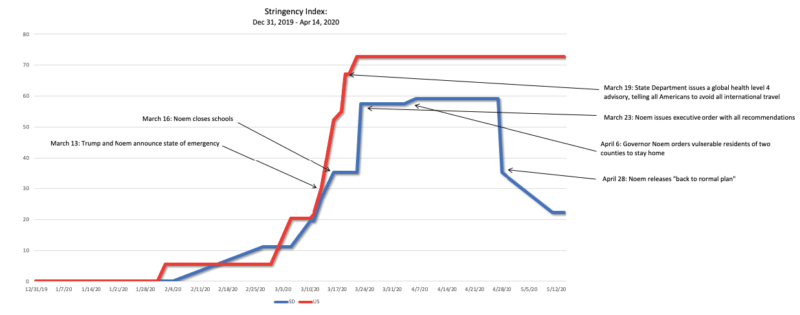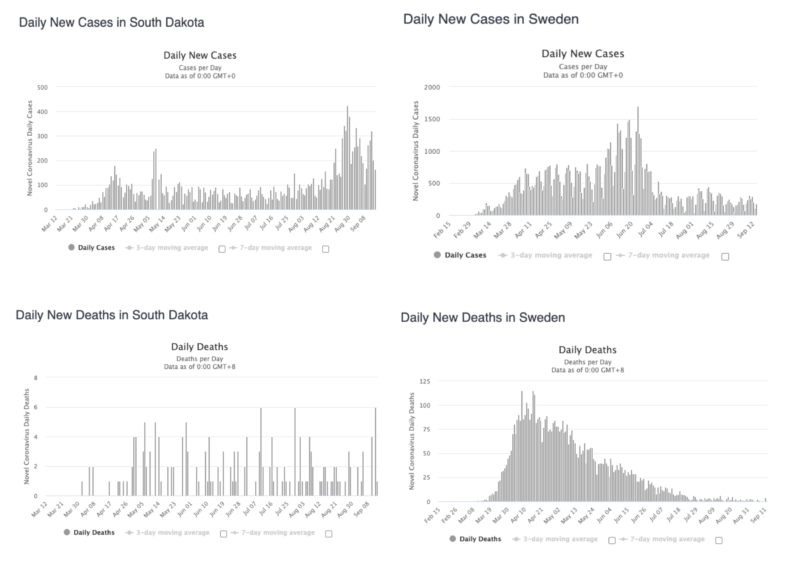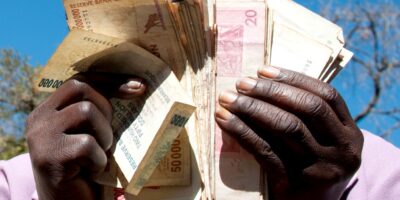South Dakota: America’s Sweden

Most people know South Dakota for the distinguished faces carved onto the side of the Black Hills mountain. Mount Rushmore reminds us of four American leaders who instilled values of freedom and hope in this country.
These values are under attack in our tumultuous coronavirus days. Lockdowns have assaulted core values that we believed were sacrosanct: property rights, in the right to run a business; freedom of association and movement, in the right to travel, gather, work, consume, have fun, and so on. In short, the right to pursue happiness.
Under the leadership of South Dakota Governor Kristi Noem, however, the Great Plains state has effected a fortress of liberty and hope protected from the grasps of overbearing politicians. And interestingly enough, South Dakota policies echo many of the same values and approaches as Sweden, and both have uncoincidentally experienced positive outcomes.
Recently, Governor Noem has been subjected to media lashings over an incredulous report regarding the Sturgis Motorcycle Rally in South Dakota, alleging that it is connected to 266,000 Covid cases. Despite pushback, Noem continues to protect the individual freedoms of South Dakotans against the speculative study, calling it “fiction” owing to faulty assumptions, data, and questionable academic modeling approaches.
Noem has rejected the familiar draconian Covid-19 mandates seen in places like California and the UK in favor of a mostly hands-off approach.
In a similar sense, Sweden’s state epidemiologist, Anders Tegnell, supported a relaxed Covid response with the country never going into lockdown despite strong pressure to do so from the European Union. While the Swedish Constitution bars politicians from intervening, expert agencies instead take charge of providing the public with noninvasive recommendations.
The coronavirus response in South Dakota and Sweden have been consistently noninterventionist in nature, leaving individual trust and common sense to direct citizens’ choices.
At the start of the pandemic, Governor Noem requested some initial restrictions, such as closing schools on March 16 while still allowing in-person check-ins for small groups. Noem also previously encouraged remote working and social distancing and recommended businesses to limit indoor capacity to 10 people when social distancing was not feasible (as recommended by the CDC). In so doing, the Governor was deferring to the prevailing policy ethos. It must have made her uncomfortable given her own commitment to freedom as a first principle.
She withdrew the initial recommendations in April in order to “[put] the power in the hands of the people, where it belongs” in prioritization of liberty.
Early on, South Dakota introduced a compulsory stay-at-home plan for those aged 65+ in two counties with high case numbers, which was rescinded May 11. Still, she never mandated stay-at-home or shelter-in-place orders, masks, or imposed bans on church gatherings, daycares, business openings, or travel.
| Date | US | SD |
|---|---|---|
| 12/31/2019 | China reports coronavirus to WHO. | |
| 1/6/2020 | CDC issues level I travel notice for Wuhan, China. | |
| 1/27/2020 | CDC issues level III travel health notice to avoid nonessential travel to China. | SD launches COVID-19 website. |
| 1/29/2020 | The formation of the White House Task Force is announced. | |
| 1/31/2020 | Trump Administration declares a public health emergency, announcing Chinese travel restrictions, suspended entry into US for foreign nationals who could spread coronavirus. Dept of Homeland Security directs all flights from China to 7 US airports. | |
| 2/2/2020 | The CDC expands entry screening to 8 US airports. | |
| 2/4/2020 | Trump gives State of the Union Address. | |
| 2/27/2020 | News release on SD preparations for COVID-19. | |
| 2/28/2020 | Governor Noem makes first statement about COVID-19. | |
| 2/29/2020 | FDA allows labs to begin coronavirus testing. Trump Administration announces level 4 travel advisory for Italy and South Korea. Bars travel to Iran and entry of foreign citizens who visited Iran in the past 2 weeks. | |
| 3/5/2020 | Noem issues first press release. | |
| 3/10/2020 | Noem announces state has five cases and one death. | |
| 3/11/2020 | Trump announces travel restrictions on foreigners who visited Europe in last 14 days. | |
| 3/13/2020 | Trump declares national emergency to access $42 billion of funds. | Noem declares state of emergency. |
| 3/16/2020 | Trump holds tele-conference with governors, announces first potention vaccine has entered trial phase 1, announced “15 days to slow the spread” guidance. | Schools are closed in SD. |
| 3/18/2020 | Trump closes US-Canada border to nonessential travel. | |
| 3/19/2020 | Trump announces drug hydroxychloroquine and State Department issues a global health level 4 advisory, telling all Americans to avoid all international travel. | |
| 3/20/2020 | US restricts nonessential traffic across Mexico border. | |
| 3/22/2020 | Noem says she does not have the authority to close restaurants and bars. | |
| 3/23/2020 | Trump invokes executive order to prohibit hoarding medical supplies. | Noem issues executive order that are all recommendations. |
| 3/27/2020 | Trump signs CARES Act into law. | |
| 3/28/2020 | CDC issues new guidance for residents of NY, NJ, CT to avoid nonessential domestic travel for 14 days. | |
| 3/29/2020 | Trump announces CDC guidelines will be extended through April 30. | |
| 4/3/2020 | White House and CDC recommend Americans wear face coverings in public. | |
| 4/6/2020 | Noem orders vulnerable residents of two counties to stay home. | |
| 4/14/2020 | Trump halts funding to WHO | |
| 4/16/2020 | Trump announces federal guidelines to reopen the US, putting responsibility on the governors. | |
| 4/20/2020 | Dept of Homeland Security extends travel restrictions with Canada and Mexico for another 30 days. President Trump said that he is temporarily suspending immigration to the United States. | |
| 4/27/2020 | President Trump announces a new federal coronavirus testing “blueprint” to aid governors in ramping up capacity as a handful of states begin lifting stay-at-home restrictions. | |
| 4/28/2020 | Noem releases “back to normal” plan. | |
| 5/11/2020 | Noem lifts order for vulnerable population in the 2 counties. | |
| 5/12/2020 | Fauci and Trump Admin officials testify at Senate hearing about coronavirus response. Fauci warns of consequences if governors reopen their states. | |
| 5/14/2020 | CDC releases guidance for schools, businesses to use as states reopen. |
Sweden, like South Dakota, made suggestions for precautionary measures, such as working from home and social distancing when necessary. Sweden banned gatherings of more than 50 people, temporarily closed secondary education and universities, and prohibited visitors from nursing homes. Otherwise, trust was placed on individuals to make prudent decisions in slowing the spread of the virus.
Tegnell explains how trust and transparency have played a role in Sweden’s response:
“Having sort of a conversation with the public, putting a lot of trust in the public and giving a little responsibility to the individuals, which is exactly what our communicable disease laws are telling us to do. And by following the pattern. Doing this, we could keep the number of cases down, and we could keep our health services working.”
Similarly, South Dakotans relied on trust and open information; Noem states:
“Now my approach to this virus was to provide South Dakotans with all the information that I could and then trust them to exercise their freedom to make the best decision for themselves and for their families.”
Noem avoided imposing aggressive restrictions, deferring to citizens to use common sense: practicing good hygiene and social distancing when necessary. She is keeping schools open throughout the fall based on the need to support young people’s educational and social needs and the low risk associated with their contracting Covid. A shocking 30% of all SD children never logged online to participate in remote learning in the spring of 2020. This statistic, coupled with the questionable effectiveness of online learning, makes a return to the classroom all the more urgent.
Noem also believes that masks do not need to be required for children, but is permitting local jurisdictions to make their own decisions in that regard. She is concerned that masks will create more issues for children:
“They’re constantly touching [the mask], taking it off, dropping it on the floor. Those all increase rates of infection, and it is certainly not an environment that is going to help them stay safe.”
On a similar note, Sweden has not enforced public mask use due to the lack of evidence supporting its effectiveness and other issues presented by widespread mask wearing. Both Tegnell and Noem believe that a side effect of widespread, mandatory masking is obscuring epidemiological problems: fostering the idea that there are easy solutions, which in turn foments further issues.
Tegnell reasons:
“We are worried (and we get at least tales from other countries) that people put on masks and then they believe they can go around in society being close to each other, even going around in society being sick. And that, in our view, would definitely produce higher spread than we have right now.”
Governor Noem echoes that sentiment:
“People should have the freedom to wear masks if it makes them feel safe, but the science on masks is very mixed.”
Despite their generally laissez-faire responses to the novel coronavirus pandemic, South Dakota and Sweden have observed low infection and death rates relative to their neighboring states and countries, respectively. Although there has been an upward tick in the number of cases, deaths still remain low, and both economies are performing well. Stockholm is additionally alleged to be one of the first places in the world to have achieved herd immunity.
South Dakota and Sweden have realized economic benefits by defending individual liberty.
As more economic and financial data emerge, the economic triumphs of both South Dakota and Sweden are becoming evident. While we cannot draw definitive conclusions at this point, even now it is fairly clear that states that imposed stringent mandates are comparatively facing greater economic hardships than those which did not.
Gross Domestic Product (GDP)
In its first quarter, the Bureau of Economic Analysis found that South Dakota’s GDP shrunk by the second smallest amount compared to other states, by only 2.2%. This percentage is lower than the US first-quarter GDP drop of 5% and the second quarter, which fell deeper by an estimated 32.9%. Sweden, even after announcing there would be no full lockdown, experienced a Q1 GDP increase of 0.1%.
Sweden’s GDP growth for the year ended 2020 has been projected to be between -5.3% to -7.8% depending on the source. Yet, these forecasts are less concerning than those for other countries with stricter Covid restrictions. The US GDP is projected to shrink by about 7.3 to 8.5% and the UK by a disheartening 11 to 14%. Between April and June, Sweden’s economy contracted by 8.6%, which is still below the European Union’s 11.6%, Spain’s 18.5%, and France’s 13.8%.
Employment
South Dakota’s labor market has also rebounded and its unemployment rate has consistently remained below the national average. Job openings are up by 4.7% since SD’s pre-pandemic peak in job openings on March 19. According to the Minneapolis Fed, South Dakota also had the fewest low-income job losses of any state in its region.
South Dakota’s unemployment rate reached its height in April at 10.9% but has lowered since to 6% in July. Although Sweden’s unemployment rate appears to be on an upward trajectory with its highest point being just above 9%, the Nordic country and Great Plains state do not come close to the US unemployment rate peak of 14.7% or California’s at 16.4%, both having much higher stringencies than Sweden and South Dakota.
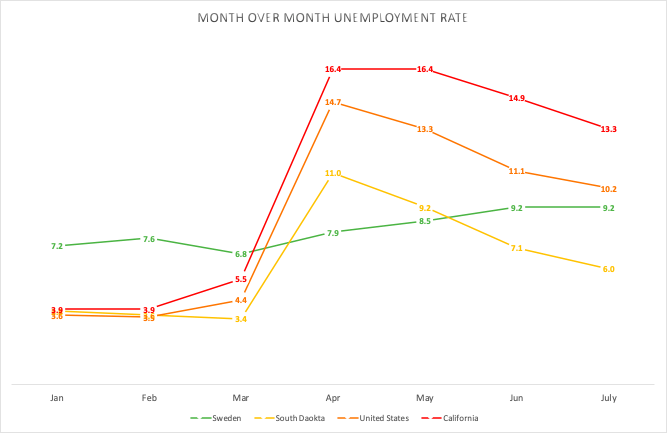
Tourism
While other states are experiencing significant declines in tourism, South Dakota faced the third lowest decline in domestic bookings behind Montana and Wyoming. Governor Noem acknowledged South Dakota’s achievement, commenting that city life is not perfect, inviting people from around the world to visit South Dakota.
Despite South Dakota’s low population density, South Dakotans have mitigated the Covid-19 spread and seen positive economic outcomes. States with stricter pandemic restrictions, on the other hand, are experiencing slower (if any) economic recoveries.
The table below compares eight states with varying stringency indexes and aims to show the different metrics that may be correlated with state stringency. The stringency index demonstrates states’ levels of severity in response to Covid-19 on a scale of 0 to 100 with 100 being the most severe.
The indexes below represent each state at its highest stringency point.

Unlike South Dakota, states including Washington, Oregon, Maine, New York, California, and Idaho chose to implement many Covid restriction policies including statewide stay-at-home orders and mandatory indoor masking, yet nevertheless have experienced higher case and death counts per capita. Although it would be fair to say that South Dakota has low figures because of its low population density, other states with low population densities – Oregon, Maine, and Idaho for example – are experiencing worse economic outcomes.
Oregon and Idaho have seen almost twice the amount of Covid-19 cases, more than twice the amount of deaths, and higher death rates compared to South Dakota. Oregon’s Q1 GDP decreased by 4.4% and Idaho’s by 4.1% (compared to South Dakota’s 2.2% decrease).
Agriculture is the top industry for Oregon and South Dakota. South Dakota’s agricultural industry saw a 0.67% increase in Q1, whereas Oregon’s decreased by 0.13% and Idaho’s by -0.57%. The stock prices of Oregon’s three top companies—Intel, Nike, and Columbia Sportswear—have plummeted as well.
Although Maine has maintained a low infection rate, the state’s economy is suffering with a Q1 2020 GDP decline of -6.30% and a slightly higher unemployment rate of 6.50% (compared to South Dakota’s 6.30%).
Month-over-month unemployment rates differ between states as well. Oregon’s unemployment peaked in April at 14.9%, which is higher than both the United States’ peak of 14.7% in April 2020 and South Dakota’s of 10.9%. While Idaho is an outlier in maintaining a generally low unemployment rate, more stringent states are experiencing greater rates of unemployment.
Iowa, which was also never locked down, shows an unemployment rate that is low; close to South Dakota’s. California, at the higher end of the stringency index (75) with indefinite lockdowns imposed on an economy the size of France’s, suffered an unemployment rate topping 16.4%.
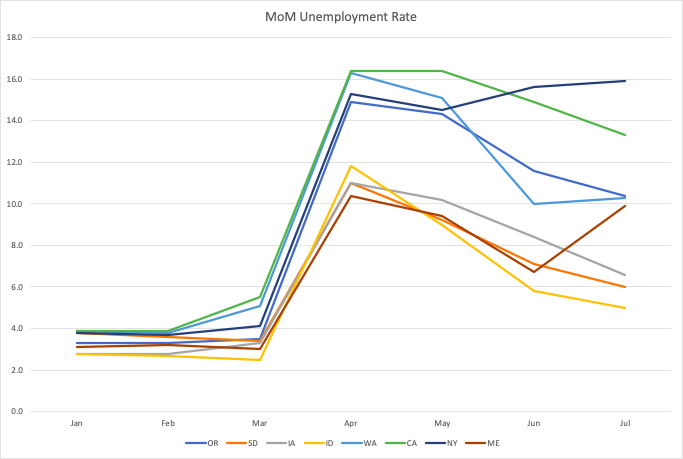
The table above illustrates another relevant point. Although only 0.7% of Oregon’s population has been sick with coronavirus, the damage to GDP and high unemployment may over time outweigh their relative Covid-19 mitigation. South Dakota and Iowa, with slightly higher infection rates, are seeing more robust economic outcomes and fewer social effects.
According to the Bureau of Economic Analysis (BEA), the accommodation and food services and the arts, entertainment, and recreation industries all suffered greatly in Q1 2020. The table below also suggests a link between higher stringency policies and consequent decreases in industry GDPs.

Encouraging the gathering and dissemination of local information, in order to facilitate personal risk assessments – all the while encouraging the truly vulnerable to protect themselves – is producing better economic and social outcomes: in South Dakota as compared to other US states, and in Sweden among nations.
Public officials at the local, state, and national levels frequently fail to realize that policies require making tradeoffs: not least of which when instituting disease mitigation measures. This has been profoundly illustrated during the course of the current SARS-CoV-2 pandemic. The perceived lockdowns have incurred tremendous economic and social costs which, it is increasingly clear, are outweighing and will over time continue to outweigh their purported benefits. Among those difficult to see and long-term costs: widespread, substandard educational outcomes; parents and extended families sacrificing work and consumption to care for children; long-term unemployment and underemployment; the irrevocable destruction of capital and know-how; rising divorce rates; child and spousal abuse; addiction (alcohol and drug abuse), and increases in the rate of suicide.
South Dakotans and Swedes, nevertheless, have understood – even if not completely, but better than nearly anywhere else – that the costs of stringent coronavirus policies are immense compared to the benefits. All states but seven issued stay-at-home orders in some capacity, and the US is bearing the costs associated with them. The BEA currently estimates that US Q2 2020 GDP fell by a staggering 32.9%. Now more than ever, Americans need to follow and cite the examples set by both South Dakota at home and Sweden abroad: examples steeped in our founding traditions of liberty, trust, and common sense.


